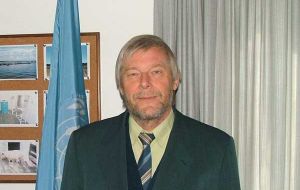MercoPress. South Atlantic News Agency
FAO working to recover fisheries in world’s second largest mountain lake
 Dr. Heimo Mikkola, FAO technical expert from Finland
Dr. Heimo Mikkola, FAO technical expert from Finland FAO is implementing a trust fund project to improve fisheries and aquaculture management in the Asian Kyrgyz Republic which aims to increase the capacity of the fisheries sector to generate food, employment and income for the rural population in an environmentally sustainable manner.
The project conducted in the field by Heimo Mikkola, FAO technical expert from Finland, will also pay special interest in improving the UN system cooperation between the related projects and relevant UN organizations working in Kyrgyzstan.
The present inland capture fisheries and aquaculture production in the Kyrgyz Republic is only about 10% of what it used to be in 1980s before the Soviet Union disintegration. Opportunities for the sector lay in the fact that the consumer demand for fisheries and aquaculture products in the country is increasing with increasing incomes and growing health concerns of the modern population
The 2009/2012 project kicked off last May with the first meeting of the Steering Committee and late in September with a workshop, in coordination with other UN organizations, on biodiversity friendly fisheries management which was attended by some 40 people from all walks of life. The three day workshop event took place in Cholpon-Ata Ecocentre at the Issyk-Kul Lake.
Issyk-Kul (*) is the world second largest mountain lake (only behind Titicaca in Bolivia) which has many problems, but most importantly the introductions of some new (alien) predatory species are blamed to have caused the disappearance of many endemic species, like Naked Osman and Issyk-Kul Marinka.
Lately tension has been growing against the Rainbow Trout cage culture since eight companies are growing rainbows in 26 cages. Fishermen and environmentalists claim that a lot of fish has escaped from the cages and free Rainbow Trout are causing further damage to the endemics.
“The truth may not be that simple, as very intensive irrigation development took place in the country during the last 30 years and heavy water abstraction led to reduced water-levels and the drying of many of the incoming streams that the endemic fish species had previously used for spawning” said FAO expert Mikkola.
However, close cooperation is needed between UNDP/GEF (United Nations Development Program/Global Environmental Facility) and FAO projects in order to avoid misunderstandings as FAO project supports the fish farming and the UNDP/GEF sees this as a big danger to all endemic fish species at the Issyk-Kul Lake.
However the FAO Project has already been able to assist the UNDP/GEF project in searching and capturing some of the most endangered species in order to reproduce these species in captivity for the restocking purposes.
One of them is an only sample of the Naked Osman (name of the endemic fish in the Issyk-Kul Lake) caught in more than a year. The previous one was only photographed in 2003.
(*) Surrounded by snow-capped peaks Lake Issyk-Kul never freezes and in Kyrgyz language means “warm lake”. It is the tenth largest lake in the world by volume and the second largest saline after the Caspian Sea. The lake covers an area of 6.236 square kilometers, stands at an altitude of 1.607 meters and is 702 meters deep. It forms part of the Issyk-Kul Biosphere Reserve.




Top Comments
Disclaimer & comment rulesCommenting for this story is now closed.
If you have a Facebook account, become a fan and comment on our Facebook Page!